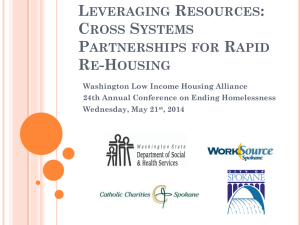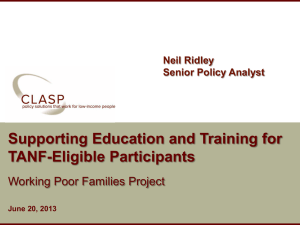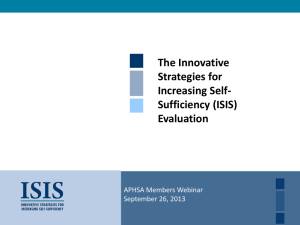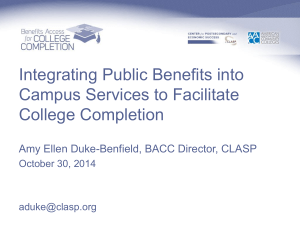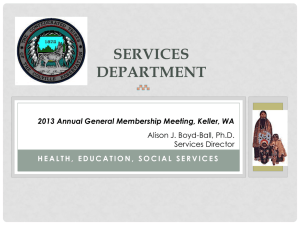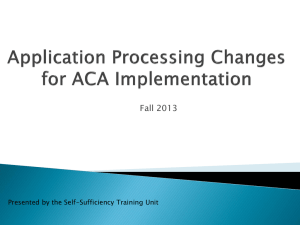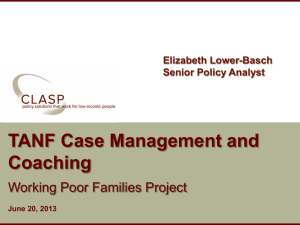Systemthinkingstuff
advertisement
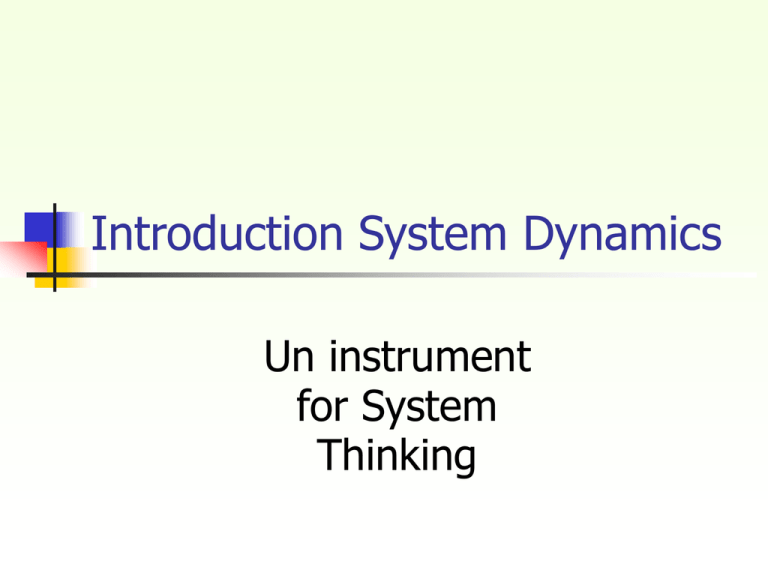
Introduction System Dynamics Un instrument for System Thinking Learning Objectives After this class the students should be able to: recognize their cognitive capacity limitation to deal is dynamic systems; understand the mean concepts of System Dynamics, such as feedback loop, delays; and archetype of systems; and interpret System Dynamics diagrams Time management The expected time to deliver this module is 50 minutes. 20 minutes are reserved for team practices and exercises and 30 minutes for lecture An experiment Suppose a simple supply chain that has been in steady-state for some time. The Retailer’s inventory has been constant at some level for a long time, steady-state supply chain A retailer maintains an inventory of product that is shipped to customers on demand. Upon shipping, the retailer always orders immediately from his supplier the same amount of product just shipped. The supplier also is very regular. He always deliveries the product to retailer 7 days after the he places the order. The supplier has never been out-of-stock (and never will be!). No product shipped by the supplier is ever, or will ever be, defective, damaged or lost in transit. Demand changes Suppose, all of a sudden, the volume of demand from customer coming into the retailer steps up to a new higher level, and then remains there. Sketch the new behavior On the axes provided in Figure I, sketch the pattern you think will be traced by the level of the retailer's inventory, over time, following the one- step-increase to customer demand. ( Each team has 5 minute to give a answer. ) Figure 1 The retailer's inventory behavior following the step-increase in demand, the Retailer's inventory will decline in a straight-line manner for 7 days; it then will level off and remain at the new, lower level. Cognitive Capacity limitation “In the long history of evolution it has not been necessary until very recent historical times for people to understand complex feedback systems. Evolutionary processes have not given us the mental ability to interpret properly the dynamic behavior of those complex systems in which we are now imbedded.” Forrester, 1973 System Dynamics In particular, to analyze how the interaction between structures of the systems and their policies determine the system behavior Methodology behavior to study systems Filling a cup of water Each team is invited to describe through any kind of diagram (or algorithm) the process to fill a cup of water. Imagine this as an exercise of operation management. (10 minutes) Language: causal diagram Faucet Position Desired Water Level Perceived Gap Water Flow Current Water Level Feedback loop and Delay When we fill a glass of water we operate "water-regulation" system involving five variables: our desired water level, the glass's current water level; the gap between the two; the faucet position; and and the water flow. in a These variables are organized in a circle or loop of cause-effect relationships which is called a "feedback process.“ Delays are Interruptions consequences between actions and their Feedback loop with delay Faucet Position Desired Water Level Perceived Gap Water Flow Current Water Level The means of arrows Desired Water Level Faucet Position Perceived Gap Water Flow Current Water Level Negative feedback + Desired Inventory Level + Perceived Gap - Order Placed Current Inventory Level + Supply Line + Balancing Process for Adjusting Cash Balance to Cash Surplus or Shortage Positive feedback Positive Word Mouth + Satisfied Customers Reinforcing Sales Process Caused by Customers Talking to Each Other About Your Product Archetypes of systems Certain patterns of structure recur again and again. These generic structures are named "systems archetypes". Archetype systems are a set of reinforcing and balancing feedback and delays interconnected. A relatively small number of these archetypes are common to a very large variety of management situations. Approach developed to study system behaviors taking into account complex structures of feedbacks and time delays. The industrial environment, seen as a set of stocks and activities linked by flow of information and flow of material submitted to time delays, is a typical object for System Dynamics study. Creating our own Market Limitation People Express example People Express example Reference Peter Senge, The Fifth Discipline, 1990 Chapter 5 Learning in and about Complex Systems Sterman (1994) Real World Unknown structure Dynamic complexity Time Delays Impossible experiments Virtual World Implementation Game playing Decisions Inconsistency Short term Known structure Variable Complexity Controlled Experiments Selected Missing Information Delayed Feedback Biased Ambiguous Strategy, Structure, Inability to infer dynamics from Decision Rules mental models Misperceptions Mental Unscientific Biases Models Defensiveness Dynamic Complexity arises because systems are… Changing over time Tightly coupled Governed by feedback Nonlinear: changing dominant structure Self-organizing Adaptive Counterintuitive Policy resistant Characterized by tradeoffs System Dynamics Contributions Thinking dynamically Move from events and decisions to patterns of continuous behavior over time and policy structure Thinking in circular causal / feedback patterns Self-reinforcing and selfbalancing processes Compensating feedback structures and policy resistance Communicating complex Thinking in stocks and flows Accumulations are the resources and the pressures on policy Policies influence flows Modeling and simulation Accumulating (and remembering) complexity Rigorous (daunting) model evaluation processes The system dynamics modeling process Perceptions of System Structure Comparison and Reconcilation Representation of Model Structure Adapted from Saeed 1992 System Conceptualization Model Formulation Empirical and Inferred Time Series Comparison and Reconciliation. Deduction Of Model Behavior Processes focusing on system structure Mental Models, Experience, Literature Perceptions of System Structure Comparison and Reconcilation Representation of Model Structure Diagramming and Description Tools Empirical Evidence System Conceptualization Model Formulation Processes focusing on system behavior Empirical Evidence System Conceptualization Model Formulation Literature, Experience Empirical and Inferred Time Series Comparison and Reconciliation. Deduction Of Model Behavior Computing Aids Two kinds of validating processes Mental Models, Experience, Literature Empirical Evidence Perceptions of System Structure System Conceptualization Comparison and Structure Reconcilation Validating Processes Representation of Model Structure Diagramming and Description Tools Model Formulation Literature, Experience Empirical and Inferred Time Series Behavior Validating Processes Comparison and Reconciliation. Deduction Of Model Behavior Computing Aids Six Traditions Contributing to the Evolution of Feedback Thought •Biology: math models •Econometrics •Engineering •Social Sciences •Biology: homeostasis •Logic Two Threads of Feedback Thought •System dynamics arises in the servomechanisms thread (the first four in this list) QuickTime™ and a TIFF (LZW) decompressor are needed to see this picture. Forrester’s Hierarchy of System Structure Closed boundary around the system Feedback loops as the basic structural elements within the boundary Level [stock] variables representing accumulations within the feedback loops Rate [flow] variables representing activity within the feedback loops Goal Observed condition Detection of discrepancy Action based on discrepancy The Endogenous Point of View The closed causal boundary takes top billing Dynamics arise from interactions within that boundary Systems thinking is the mental effort to uncover endogenous sources of system behavior. Dynamics New York City Population, 1900-2000 Bronx Brooklyn Manhattan Queens Staten Island 9000000 8000000 7000000 6000000 5000000 4000000 3000000 2000000 1000000 0 1900 1910 1920 1930 1940 1950 1960 1970 1980 1990 2000 Global Atmospheric Methane (1860-1994) Global Atmospheric Methane 400 350 300 250 200 150 100 50 1860 0 Global Average Temperature (Reconstruction 1400-1980; Data 19021998) Quic kTime™ and a TIFF ( LZW) dec ompres s or are needed to s ee this pic ture. Stocks and Flows Stocks and flows help to explain self-reported drug use data Have ever used Potential users Frequent users Occasional users Past users The Simplified Structure--p. 133 Reputation Fleet size & flights R No. of pass. carried B Revenues Service quality Delay Service quality stan Service capacity B P erceived need to improve quality Delay2 Additions to service capacity Structure growing action Reinforcing state of stock slowing action Balancing The Simplified Structure-variables NAME Actual Inventory Desired Inventory Order Rate Adjustment Time MNEMONIC AI DI OR AT Desired invent o ry Invent ory Order rat e Adjust m ent t im e dEMAN D The Simulation Structure-Reinforcing Loop L ifet im e Deprec Flight s/yr Flight s/$-y r Fleet capit al Avg. load fact or Addns t o f leet capit al R No. of pass carried/y r Rev. t o fleet fract Revenues/yr Avg. Revenue/pass ‘Challenging the clouds’ in a study of leasing in the automobile industry ? New vehicle inventory Production Purchase or lease “We’re not in the used car business!” Stocks and flows in new car purchase and leasing Relative attractiveness of leased cars Used inventory Trade cycle Purchase used Vehicles being driven New vehicle inventory Production Sell or trade in Purchase or lease Scrapping Intuitive view of effect of leasing on auto sales: Leased car pipeline Stocks and Flows in Global Warming Thought experiment: Capital stock capital investment CO2 annual production Atmospheric CO2 Breakdown of atmopheric CO2 Economic activity incoming solar heat energy Global heat energy outgoing global heat energy Life of aerosols in atm Life of GH gases in atm Aer osols i n atm Aer osol br eakdown Aer osol pr oduction But although the stock-and-flow insight holds, global climate is of course much more complex than that. GH g ases in atm GH g as pr oducti on GH g as br eakdown Aer osol al bedo efct Aer osol concentr ati on Atm volume Atm volume ~ GH g as concentr ation ~ Ice and cloud cover Total albedo ~ Ear th Ocean and Atm heat Cloud cover GH g as reten efct Ear th ar ea Solar heat reachi ng ear th Ear th heat radi ati on Ear th ar ea ~ Ice cover Cloud reten efct Ice thi ckness ~ Solar heat incoming Water vap reten efct Sur face temp Ice ar ea Cloud thickness Cloud ar ea CO2 r eten efct Atm temp ~ Ice density Atm volume Net thawing factor Evap factor Ice volume Ear th ice Ear th water Net thawing And still much more complex than this simple global climate model, as well! Cloud volume Water vap conc Water vapor in atm Cloud density Water in clouds Evaporation Condensation Water density Precipitati on Ear th water vol ume Atm volume CO2 atm conc CO2 water conc Ear th photosynthesi s Ocean photosynthesis CO2 i n atm CO2 i n oceans Car bon in ocean biomass Ocean CO2 br eakdown CO2 ocean r el ease Atm CO2 breakdown Car bon in earth biomass Ear th biomass decay Ocean biomass decay Ocean CO2 pr oduction CO2 ocean uptake Atm CO2 production Feedback Thinking “For one good deed leads to another good deed, and one transgression leads to another transgression.” (Pirke Avot) The Classic Cybernetic Balancing Loop Goal Perceived gap Perceived state Planned action to reduce gap Implicit, unstated goals Implemente d action Actual state of the system Changes in the State of the system Intended actions The Cybernetic Loop with Complications Goal Perceived gap Perceived state Autonomous changes in the state of the system Actual state of the system Changes in the State of the system Planned action to reduce gap Implicit, unstated goals Implemente d action Intended actions The Cybernetic Loop with Complications Goal Perceived gap Perceived state Autonomous changes in the state of the system Actual state of the system Changes in the State of the system Planned action to reduce gap Implicit, unstated goals Implemente d action Intended actions Unintended actions The Cybernetic Loop with Complications Goal Perceived gap Perceived state Autonomous changes in the state of the system Actual state of the system Changes in the State of the system Planned action to reduce gap Implicit, unstated goals Implemente d action Intended actions Unintended actions Ramifying effects A Classic Reinforcing Loop (Myrdal 1944, Merton 1948) Prejudice against the minority group Majority’s perception of the inferiority of the minority (R) Economic and educational discrimination against the minority Achievements of the minority group Structure and Dynamics of Terrorist Cells (R) Peripheral support for terrorists Terrorist funding (R) Interfering with terrorist funding Terrorist actions Efforts to suppress terrorists (B) (R) Terrorist zeal (B) Recruiting (R) terrorists (R) Terrorist group Terrorist martyrs to the cause (B) (B) Losing terrorists (R) Insights about building teamwork in a public school Teamwork and Communication are self-reinforcing Quality of communication + Trust + (+) Risk taking + Quality of communication within teams + Teamwork + Resistance to teamwork Isolation of teams and punishing risk-taking inhibit the growth of trust + Quality of communication + + Positive responses to experiments ? Trust + (+/-) Individual experiments (+) Risk taking Quality of communication between teams + (-) Quality of communication within teams + Teamwork + - + Resistance to teamwork But longterm experience with teamwork can build communication Quality of + communication + between teams + Quality of (-) communication Quality of + (+) communication + + within teams Trust (+) + Cumulative Positive + Risk experience with responses to Teamwork taking teamwork (+/-) experiments + + ? + Individual Resistance to + + experiments Team teamwork effectiveness - Risk taking can enhance effectiveness, which can build trust Quality of + communication + between teams + Quality of (-) communication Quality of + (+) communication + + within teams Trust (+) + Cumulative Positive + Risk experience with responses to Teamwork taking teamwork (+/-) experiments + + ? + Individual Resistance to + + experiments Team teamwork effectiveness + + Personal learning Average personal effectiveness + A team-player culture is self-reinforcing: an opportunity or a trap Quality of + communication + between teams + Quality of (-) communication Attractiveness Quality of + (+) of the org to communication + + within teams + team players Trust (+) + Cumulative Positive + Risk experience with responses to Teamwork + taking teamwork (+/-) experiments + Fraction of staff who are + ? team players + Individual Resistance to + + experiments Team teamwork + effectiveness + + Personal learning Average personal effectiveness + Likely leverage points + Extent of Learning Organization characteristics present Quality of communication + + Trust (+) + + Positive responses to experiments ? + (+/-) Teamwork + - + Resistance to teamwork + Team effectiveness - + Personal learning + Dialogue training Attractiveness of the org to + team players Cumulative experience with teamwork + Individual experiments Adm teaching role Risk taking + Quality of communication + + between teams + (-) Quality of (+) communication + within teams + Average personal effectiveness + + + Fraction of staff who are team players + + Understanding stages of community building The Problem: 1996 U.S. welfare reform Since 1930, a guarantee of lifetime Federal support 1996 legislation ended that: Temporary Assistance for Needy Families - TANF At most five years of Federal support in one’s lifetime The clock started for everyone on TANF in 1997 People began timing out in 2002 Financial burden will begin shifting to the states and counties A series of facilitated group modeling efforts in three New York State counties tried to help Three Policy Mixes Base run (for comparison) Investments in the “Middle” Flat unemployment rate Historical client behaviors Additional services to TANF families Increased TANF assessment & monitoring Safety net assessment & job services Investments on the “Edges” Prevention Child support enforcement Self-sufficiency promotion Investing in the “Middle” Investing on the “Edges” Base, “Edges,” and “Middle” Compared: Populations on the Welfare Rolls “Edges” looks better. Total Job-Finding Flows from TANF “Middle” looks better. Program Expenditures “Edges” looks worse, then better. Populations in the Welfare System “Middle” looks worse than “Base”! “Edges” looks much better. Total Recidivism Flows (back to TANF) The hint for understanding the puzzling dynamics: recidivism. A Stock-and-Flow Archetype at Work Here + (R) Probability of recidivism Recidivism Families on TANF Enter TANF Job finding rate Post TANF employed To mainstream employment (R) Load on TANF support capacity (R) Time to find first job Load on employment support capacity + Behavior of the Archetype in response to increased TANF support capacity 6,000 Total families at risk 4,500 Families on TANF 3,000 1,500 Post-TANF employed 0 0 6 12 18 Fam ilies on T ANF : archet ype base P ost T ANF employed : archet ype base T otal families at risk : archet ype base 24 30 36 T im e (M ont h) 42 48 54 60 families families families The Behavior of the Archetype Families on TANF initially declines, as more support hastens job finding. Post-TANF families employed initially increases, just as policy makers would predict. Eventually (it takes a year and a half to begin to see it), … Families on TANF rises higher to a new high, Post-TANF Employed declines to a new low, And Total Families at Risk rises! Why? • Increasing TANF support • Speeds job finding, • Swamping downstream Post-TANF jobs and support Time in post TANF employ Outflow from post TANF employ Recidivism Enter TANF + Families on TANF Load on TANF support capacity TANF support capacity + - Job finding rate Time to find first job + Post TANF employed - To mainstream employment Load on employment support capacity Post TANF employment support capacity Probability of recidivism Misattribution? Desirable rise in Post-TANF employed continues for almost a year and half after the intervention Families on TANF falls below initial for over a year after increasing TANF support capacity Very hard (impossible?) to see that the rise in Total Families at Risk is attributable solely to the improvement in TANF support capacity Dynamics almost certainly to be blamed on a weakening economy, a rise in client pathologies, or other exogenous factors A Loop View of the Archetype in Detail Time in post TANF employ Outflow from post TANF employ Recidivism Enter TANF + Families on TANF Load on TANF support capacity TANF support capacity + - Job finding rate Time to find first job + Post TANF employed - To mainstream employment Load on employment support capacity Post TANF employment support capacity Suppose TANF support capacity increases… Probability of recidivism 4,000 White bar (left) is the time slice of interest 3,000 B: Employed load controls recidivism 2,000 Red arrows (below) are the dominant influences 1,000 0 0 30 60 Time (Month) 90 Time in post TANF employ 120 Outflow from post TANF employ Recidivism Enter TANF + Families on TANF Load on TANF support capacity TANF support capacity + - Job finding rate Time to find first job + Post TANF employed - To mainstream employment Load on employment support capacity Post TANF employment support capacity Probability of recidivism 4,000 3,000 B: Employed load controls recidivism 2,000 1,000 0 0 30 60 Time (Month) 90 Time in post TANF employ 120 Outflow from post TANF employ Recidivism Enter TANF + Families on TANF Load on TANF support capacity TANF support capacity + - Job finding rate Time to find first job + Post TANF employed - To mainstream employment Load on employment support capacity Post TANF employment support capacity Probability of recidivism 4,000 3,000 B: Employed load controls recidivism 2,000 1,000 0 0 30 60 Time (Month) 90 Time in post TANF employ 120 Outflow from post TANF employ Recidivism Enter TANF + Families on TANF Load on TANF support capacity TANF support capacity + - Job finding rate Time to find first job + Post TANF employed - To mainstream employment Load on employment support capacity Post TANF employment support capacity Probability of recidivism 4,000 3,000 B: Employed load controls recidivism 2,000 1,000 0 0 30 60 Time (Month) 90 Time in post TANF employ 120 Outflow from post TANF employ Recidivism Enter TANF + Families on TANF Load on TANF support capacity TANF support capacity + - Job finding rate Time to find first job + Post TANF employed - To mainstream employment Load on employment support capacity Post TANF employment support capacity Probability of recidivism 4,000 White bar (left) is the time slice of interest 3,000 B: Employed load controls recidivism 2,000 Red arrows (below) are the dominant influences 1,000 0 0 30 60 Time (Month) 90 Time in post TANF employ 120 Outflow from post TANF employ Recidivism Enter TANF + Families on TANF Load on TANF support capacity TANF support capacity + - Job finding rate Time to find first job + Post TANF employed - To mainstream employment Load on employment support capacity Post TANF employment support capacity Probability of recidivism 4,000 3,000 B: Employed load controls recidivism 2,000 1,000 0 0 30 60 Time (Month) 90 Time in post TANF employ 120 Outflow from post TANF employ Recidivism Enter TANF + Families on TANF Load on TANF support capacity TANF support capacity + - Job finding rate Time to find first job + Post TANF employed - To mainstream employment Load on employment support capacity Post TANF employment support capacity Probability of recidivism 4,000 3,000 B: Employed load controls recidivism 2,000 1,000 0 0 30 60 Time (Month) 90 Time in post TANF employ 120 Outflow from post TANF employ Recidivism Enter TANF + Families on TANF Load on TANF support capacity TANF support capacity + - Job finding rate Time to find first job + Post TANF employed - To mainstream employment Load on employment support capacity Post TANF employment support capacity Probability of recidivism 4,000 3,000 B: Employed load controls recidivism 2,000 1,000 0 0 30 60 Time (Month) 90 Time in post TANF employ 120 Outflow from post TANF employ Recidivism Enter TANF + Families on TANF Load on TANF support capacity TANF support capacity + - Job finding rate Time to find first job + Post TANF employed - To mainstream employment Load on employment support capacity Post TANF employment support capacity Probability of recidivism 4,000 3,000 B: Employed load controls recidivism 2,000 1,000 0 0 30 60 Time (Month) 90 Time in post TANF employ 120 Outflow from post TANF employ Recidivism Enter TANF + Families on TANF Load on TANF support capacity TANF support capacity + - Job finding rate Time to find first job + Post TANF employed - To mainstream employment Load on employment support capacity Post TANF employment support capacity Probability of recidivism 4,000 Dynamic complexity even in a structure this aggregate and tiny! 3,000 B: Employed load controls recidivism 2,000 1,000 0 0 30 60 Time (Month) 90 Time in post TANF employ 120 Outflow from post TANF employ Recidivism Enter TANF + Families on TANF Load on TANF support capacity TANF support capacity + - Job finding rate Time to find first job + Post TANF employed - To mainstream employment Load on employment support capacity Post TANF employment support capacity Probability of recidivism System Dynamics and Dynamic Complexity Thinking dynamically moves us beyond separate events and decisions, toward understanding. Feedback thinking extends traditional causal thinking. It improves (makes more realistic) how we think about the world and how we think about changing it. Create your own “Shifting the Burden” Story Is there a problem that is getting gradually worse over the long term? Is the overall health of the system gradually worsening? Is there a growing feeling of helplessness? Have short-term fixes been applied? The Casa Olay problem of using cupouns to generate business and then can’t get away To structure your problem Identify the problem Next, identify a fundamental solution Then, identify one or several symptomatic solutions Finally, identify the possible negative “side effects” of the symptomatic solution Review We have now seen two of the basic systems archetypes. The Limits to Growth Archetype The Shifting the Burden Archetype As the archetypes are mastered, they become combined into more elaborate systemic descriptions. The basic “sentences” become parts of paragraphs Seeing Structures, not just Trees Helps us focus on what is important and what is not Helps us determine what variables to focus on and which to play less attention to WonderTech: The Chapter 7 Scenario A lesson in Growth and Underinvestment What Senge gets out of this is the Growth and Underinvestment Archetype A combination of variants of the Limits to Growth Archetype and the Shifting the Burden Archetype The WonderTech Scenario WonderTech continues to invest in the growth side of the process. Sales grow but then plateau. Management puts more sales people into the field. Offers more incentives to sales force. But because of long lead times, customers wane. “Yes you have a great product, but you can’t deliver on your lead time promise of eight weeks. We know; we’ve heard from your other customers.” In fact, the company relaxed its lead-time standard out to twelve to sixteen weeks because of The Reinforcing Loop Size of Sales Fo rce REINFOR CING Revenues Number of Orders The Balancing Loop: Following the LTG Archetype Sales Diff iculty Size of Sales Force Number of Orders Revenues Size of Backlog Delay Delivery T ime The Growth Curve: Page 117 What’s happened? WT’s management did not pay much attention to their delivery service. They mainly tracked sales, profits, market share and return on investment. WT’s managers waited until demand fell off before getting concerned about delivery times. But this is too late. The slow delivery time has already begun to correct itself. The management was not very concerned about the relaxed The WonderTech Scenario The firm decides to build a new manufacturing facility. But the facility comes on line at a time when sales are declining and lead times are coming back to the eight-week standard. Of every 10 startup companies, 5 will disappear with five years, only 4 survive into their tenth year and only 3 into their fifteenth year. The Shifting the Burden Component Sales Dif ficulty Number of Orders Delay Size of Backlog Delivery T ime Delivery time standard P roduction Capacity P erceived need to im prove delivery tim e Delay2 P lanned additions to capacity Put the whole thing together Comments on The Senge Methodology Sees problems as conforming to a finite number of “archetypes” Formulates models based on combinations of the archetypes Addresses problem-driven situations What about situations and systems that are technology-driven, dynamics-driven, exogenously-driven, anything but problemdriven More Comments on the Senge Methodology But does this become sufficiently general to accommodate all dynamical “scenarios and situations”? It is difficult to translate his archetypes and causal models into running system dynamics simulations A lot of variables (RATE VARIABLES, specifically) get left out in terms of connections More Comments on the Senge Methodology The focus is on characterizing the dynamics, not on how to capture that in terms of stocks, flows and information paths He doesn’t label his edges with “+” or “-” signs Another methodology: The Sector Approach to SD model formulation Begin by identifying the sectors Determine the within-sector structure A “sector” is all the structure associated with a single flow There could be several states in a single sector Reuse existing “molecules” where possible Determine the between-sector information infrastructure A Single-sector Exponential goal-seeking Model Sonya Magnova is a television retailer who wishes to maintain a desired inventory of DI television sets so that she doesn’t have to sell her demonstrator and show models. Sonya’s ordering policy is quite simple--adjust actual inventory I toward desired inventory DI so as to force these to conform as closely as possible. The initial inventory is Io. The time required for ordered inventory to be received is AT. A Two-sector Housing/population Model A resort community in Colorado has determined that population growth in the area depends on the availability of hoousing as well as the persistent natural attractiveness of the area. Abundant housing attracts people at a greater rate than under normal conditions. The opposite is true when housing is tight. Area Residents also leave the community at a certain rate due primarily to the availability of Two-sector Population/housing Model, Continued The housing construction iindustry, on the other hand, fluctuates depending on the land availability and housing desires. Abundant housing cuts back the construction of houses while the opposite is true when the housing situation is tight. Also, as land for residential development fills up (in this mountain valley), the construction rate decreases to the level of the demolition rate of houses. What are the main sectors and how do these interact? Population Housing What is the structure within each sector? Determine state/rate interactions first Determine necessary supportng infrastructure PARAMETERS AUXILIARIES What does the structure within the population sector look like? RATES: in-migration, out-migration, net death rate STATES: population PARAMETERS: in-migration normal, outmigration normal, net death-rate normal What does the structure within the housing sector look like? RATES: construction rate, demolition rate STATES: housing AUXILIARIES: Land availability multiplier, land fraction occupied PARAMETERS: normal housing construction, average lifetime of housing PARAMETERS: land occupied by each unit, total residential land What is the structure between sectors? There are only AUXILIARIES, PARAMETERS, INPUTS and OUTPUTS What are the between-sector auxiliaries? Housing desired Housing ratio Housing construction multiplier Attractiveness for in-migration multiplier PARAMETER: Housing units required per person System Dynamics Douglas M. Stewart, Ph.D. Anderson Schools of Management University of New Mexico Adapted from Senge, P. The Fifth Discipline, Doubleday/Currency, 1990. Why System Dynamics TQM requires a systems view of the world A new paradigm required See the interrelationships rather than the linear cause-effect chains See the process of change rather than a snapshot In systems thinking every influence is both a cause and effect Introduction to Systems Diagrams From any element in a situation you can trace arrows that represent the influence on another element. Example: Filling a glass of water Am I filling the glass of water? Desired Water Level Faucet Position Perceived Gap Water Flow Current Water Level Or is the level of water controlling my hand? Building Blocks of Systems Thinking Reinforcing Loops (Positive Feedback) Balancing Loops (Negative Feedback) Delays Reinforcing Loops If the product is good we have a virtuous cycle. Sales Positive Word of Mouth Satisfied Customers If the product is bad we have a vicious cycle. Reinforcing Loops The snowball effect Accelerating growth or accelerating decline These systems can take you by surprise! Balancing Loops Body Temperature Desired Body Temperature Adjust Clothing Temperature Gap Balancing Loops System reverts to status quo Often in business the goals are implicit When there is resistance to change, look for a hidden balancing process Delays: The Sluggish Shower Current Water Temperature Shower Tap Setting Desired Water Temperature Temperature Gap Delays When you tell the story add the word “eventually” Cause the system to overshoot the target Aggressive action produces the opposite of what is intended An Example: Reducing Burnout Actual Hours Worked Threat of being perceived as uncommitted Implicit goal of 70 hour workweek Heroism Gap Archetype 1: Limits to Growth A reinforcing process is begun to produce a desired result. It works, but also creates unintended side-effect (a balancing process) that eventually slows down success. Limits to Growth Size of Market Niche Motivation and Productivity Morale Growth Promotion Opportunities Where is the leverage? Saturation of Market Niche Limits to Growth The tendency is to push hard The leverage not in the reinforcing loop, but removing the limits on the balancing loop Don’t push growth. Remove the factors that limit growth Archetype 2: Shifting the Burden An underlying problem generates symptoms that demand attention. But…underlying problem is obscure or costly to confront. So… people shift the burden to other solutions that address the symptoms. Shifting the Burden Bring in HR Expert Personnel Performance Problems Develop Managers’ Abilities Expectations that HR Experts will solve problem Shifting the Burden Beware the symptomatic solution Benefits are short term at best Pressure on symptomatic response only gets larger Archetype 3: Eroding Goals A shifting the burden type structure where the short term solution is letting the long term goal decline. Customers are dissatisfied with late schedules. Production scheduling never really under control. Company says we ship to schedule 90% of time. But…every time the schedule begins to slip, they add to quoted delivery times. Eroding the Goals Pressures to Adjust Goal Goal Early warning symptom: “It’s OK if our performance standards slide just a little until the crisis is over” Gap Condition Actions to Improve Conditions Principle: Hold the vision Archetype 4: Success to the Successful Two activities compete for limited resources. The more successful one becomes, the more support it gains, thereby starving the other. Manager has two protégés. One gets sick for a week, the other gets preferential treatment. The first feeling approval flourishes and therefore gets more opportunity. The second, feeling insecure, languishes and eventually Success to the Successful Success of A Resources to A Warning symptom: One of two interrelated activities is beginning to do very well and the other is struggling Allocation to A instead of B Success of B Resources to B Principle: Look for overarching goal to balance both, or decouple the shared resource. Tragedy of the Commons Individuals use a joint resource on the basis of individual need. At first they are rewarded for using it. Eventually they get diminished returns, which causes them to intensify their efforts. The resource becomes depleted. Several divisions use a common retail sales force. Each is concerned that sales force will not give enough attention to their products. One manager sets higher than needed targets. Other managers followed. Sales force becomes tremendously overburdened, performance declines and turnover increases. Tragedy of the Commons Individual A’s Activity Net Gains For A Resource Limit Gain per Individual Activity Total Activity Individual B’s Activity Warning Symptom: There used to be plenty for everyone. Now things are tough. I will have to work harder to succeed. Net Gains For B Principle: Manage the commons through education and selfregulation or an official regulation Archetype 5: Growth and Underinvestment Growth approaches a limit which can be pushed out with investment in additional capacity. But if investment is not aggressive enough to forestall growth, it may never get made. People express was unable to build service capacity to keep up with demand. Firm tried to outgrow problems. Deteriorating service quality, increased competition and lower morale followed. Firm relied on underinvestment strategy until customers no longer wanted to fly airline. Principle: Build in advance of demand as strategy for developing it. Hold the vision on quality standards. Growth and Underinvestment Reputation Increased Flights Number of Passengers Revenues Warning: We used to be best and will be again, but right now we need to conserve resources and not overinvest Quality Standard Service Quality Service Capacity Perceived need To improve quality Additions to Service Capacity Spend on R&D to Drive Growth Size of Engineering Staff R&D Budget Management Complexity Revenues New Products Management Burden to Senior Engineers Product Development Time Senior Engineers Ability to Manage The growth of survey based business research. Researcher A’s Surveys Net Research For A Total # Surveys Researcher B’s Surveys Net Research For B Business Survey Tolerance Survey Burnout and Resistance What is a system? A definition as offered by Gregory Watson in his book, Business Systems Engineering: “System means a grouping of parts that operate together for a common purpose.” (Watson, 1994). What is a System? (Cont’d) Definition as adapted from Random House Dictionary: A system is an assemblage or combination of elements or parts forming a complex or unitary whole, such as a river system or a transportation system; any assemblage or set of correlated members, such as a system of currency; an ordered and comprehensive assemblage of facts, principles, or doctrines in a particular field of knowledge or thought, such as a system of philosophy; a coordinated body of methods or a complex scheme or plan of procedure, such as a system of organization and management; any regular or special method of plan or procedure, such as a system of marking, numbering, or measuring What is Thinking? What, precisely, is thinking? When at the reception of sense impressions, memory pictures emerge, this is not yet thinking. And when such pictures form a series, each member of which calls forth another, this too is not yet thinking. When, however, a certain picture turns up in many such series, then—precisely through such return—it becomes an ordering element for such series…Such an element becomes an instrument, a concept. I think the transition from free association of dreaming to thinking is characterized by the more or less dominating role which the concept plays in it (Einstein, in Schilpp, 1949). Connectedness “If you wish to understand a system, and so be in a position to predict its behavior, it is necessary to study the system as a whole. Cutting it up into bits for study is likely to destroy the system’s connectedness, and hence the system itself.” (Sherwood, 2002) Connectedness “If you wish to influence or control the behavior of a system, you must act on the system as a whole. Tweaking it in one place in the hope that nothing will happen in another is doomed to failure—that’s what connectedness is all about.” (Sherwood, 2002). Systems Theory General Systems Theory Chaos Theory Quantum Theory Ecological Theory Systems Principles Openness Purposefulness Multidimensionality Emergent property Counterintuitivess Systems Thinking Problem Solving Tool Pioneered By Biologists Looks At The Whole View Reduces Complexity Controls System Behavior Systems Thinking Methodologies Soft Systems Methodologies Hard Systems Thinking The Fifth Discipline Systems Thinking Tools Archetypes Causal Loop Diagrams Stocks and Flows Simple Structure Dynamics Systems Thinking Models Archetypes Causal Loop Diagrams Stocks and Flows Archetype: Fixes That Backfire Problem Symptom Fix Original threshold of tolerance Unintended consequences delay The problem symptom alternately improves. It goes down, then comes Back up again and usually comes back worse than before (Senge, 1994). Archetype: Limits to Growth Problem Symptom Actual performance Corrective action Growth occurs and sometimes dramatic but levels off and/or falls into decline (Senge, 1994). Archetype: Shifting the Burden Quick fixes Side effects Problem Symptom Corrective Actions delay Root cause Three patterns exist side by side. The reliance on short-term fixes grows stronger, while efforts to fundamentally correct the real problems grow weaker, and the problem symptom alternately improves and deteriorates (Senge, 1994). Archetype: Tragedy of Commons limits or constraints A’s growth process A’s growing action actual performance that A measures A’s limiting process gain per individual activity total growing action B’s limiting process B’s growth process B’s growing action TRAGIC DEGRADATION PROCESS actual performance that B measures delay Total activity grows, but the gains from individual activities are dropping off. Parts of the organization are suffering for the whole (Senge, 1994). Archetype: Accidental Adversaries A’s activity with B (actions in B’s favor) A’s unintended obstruction of B’s success A’s success A’s fixes to Improve A’s own results B’s success B’s unintended obstruction of A’s success B’s activity with A (actions in A’s favor) B’s fixes to improve B’s own results Each sides performance either declines or stays level and low, while competitiveness Increases over time (Senge, 1994). Causal Loop Diagrams O Pressure from Contractor for More Dollars Quality of the Government-Industry relationship Pressure on the Government to stay Within cost S Risk of cost overruns O S Pressure on the Government to deliver A workable system Pressure on the Government to control The contractor S Pressure on the Government to control Costs and quality S S Requirement for high Technical and service Quality standards Risk to the Government of Cost escalation S Government Cost Model Adapted From Sherwood’s Causal Loop Diagrams S S Dependency of the Government on the contractor S S Policy of outsourcing Pressure on the Government To satisfy the taxpayers S Causal Loop Diagram Total Work Capacity My Goals Your Goals My Consumption of Dollars Your Consumption of Dollars + + + - - + My Need for Work + My fear that you will Not leave enough work me + Work Available Your Need for Work + - - - Your fear that I will Not leave enough work you Number of activities competing For work + Conflict + Option 1: Two reinforcing loops (Sherwood, 2002) Causal Loop Diagram Total Work Capacity My Goals Your Goals My Consumption of Dollars Your Consumption of Dollars + + + + - - - - Work Available My Need for Work + Your Need for Work + + + My fear that you will Not leave enough work me - - Your fear that I will Not leave enough work you Police the Work allocation + + Appeal to A higher authority + Option 2: Limit consumption—before turf war (Sherwood, 2002) Causal Loop Diagram Total Work Capacity My Goals Your Goals My Consumption of Dollars - Your Consumption of Dollars + + - + + + Work Available My Need for Work - Your Need for Work + + My fear that you will Not leave enough work me My willingness to Participate in a cooperative Goal-setting process + - + - Recognition of The need for cooperation + Your fear that I will Not leave enough work you My willingness to Participate in a cooperative Goal-setting process + Option 3: Players See the Sense in Cooperation (Sherwood, 2002) Causal Loop Diagram Total Work Capacity My Goals Your Goals My Consumption of Dollars - Your Consumption of Dollars + + - + + - + Work Available My Need for Work - Your Need for Work + + My fear that you will Not leave enough work me My willingness to Participate in a cooperative Goal-setting process + - + - Recognition of The need for cooperation + + Your fear that I will Not leave enough work you My willingness to Participate in a cooperative Goal-setting process + Mutual Trust Best Solution: Goals Match—Combined Benefit! + System Dynamics: Growth and Goal Seeking Structure and Behavior Goal state of the system state of the system Time Time + Goal (desired state of the system) state of the system + Net Increase Rate R State of The System discrepancy B + Corrective action + + Stocks and Flows Valves represent the flow of inventory into and out of the warehouse Stock Inventory source sink Production (inflow) Shipments (outflows) Sources and sinks are outside the model boundary. Stocks and Flows are used in Causal Loop Diagrams to cover some of their limitations of not being able to capture stocks and flows within systems (Sterman, 2000). Some Models from Soft Systems Methodology--Checkland The inquiring/learning cycle of SSM (Checkland, 1999) perceived real-world problem or situation leads to selection of ‘comparison’ (question problem situation using models) action to improve models of relevant purposeful activity systems each based on a declared world-view find accommodations which enable a structured debate about desirable and feasible change Principles • real world: a complexity of relationships. • relationships exploded via models of purposeful activity based on explicit world visions. • inquiry structured by questioning perceived situation using the models as a source of questions. • ‘action to improve’ based on finding accommodations (versions of the situation which conflicting interests can live with) • inquiry in principle never-ending; best conducted with wide range of interested parties; give the process away to people in the situation. Method for Unstructured Problems 1. the problem situation: unstructured 7. action to improve the problem situation 2. the problem situation: expressed. 6. feasible, desirable changes 5. comparison of 4 with 2 Real world Systems thinking 4. conceptual models 3. root definitions of systems Checkland, 1999 4.a. formal systems concept 4.b. other systems thinking An area of reality containing: Concerns Issues Problems Aspirations Other sources Gives rise to IDEAS from which may be formulated provide which support criticism of THEORIES: Substantive Methodologies which present CASE RECORDS PROBLEMS documented in which may be analyzed using to be used in action (intervention, influence, observation) in which yield MODELS METHODOLOGY A developing subject which may be manipulated using TECHNIQUES which may be used in ANY DEVELOPING SUBJECT (Checkland, 1999) Laws of Systems Thinking Today’s problems come from yesterday’s solutions. The harder you push, the harder the system pushes back. Moving the problem around. Compensating feedback. Behavior grows better before it grows worse. The easy way out usually leads back in. The cure can be worse than the disease. Faster is many times slower. Cause and effect are not closely related in time and space. Small changes can produce big results—but the areas of highest leverage are often the least obvious. You can have your cake and eat it too, but not at the same time. Dividing the elephant in half does not produce two small elephants. There is no blame. Senge, 1990

